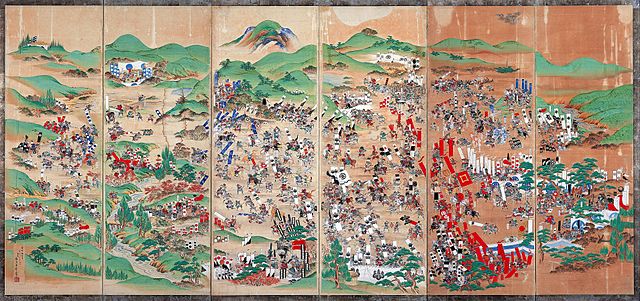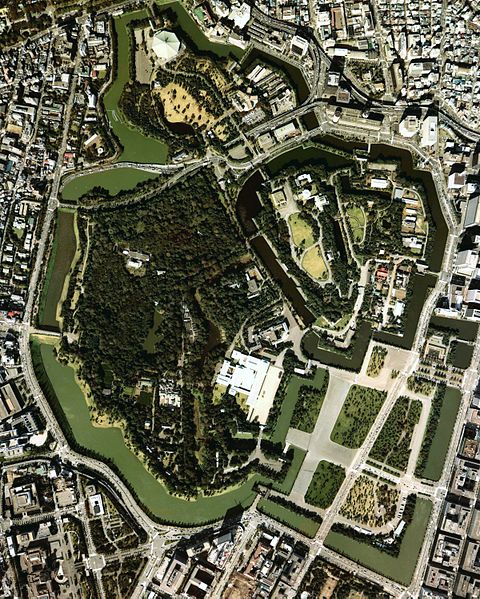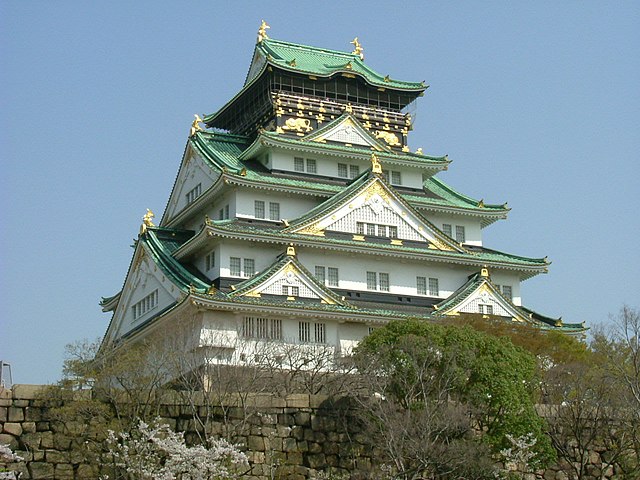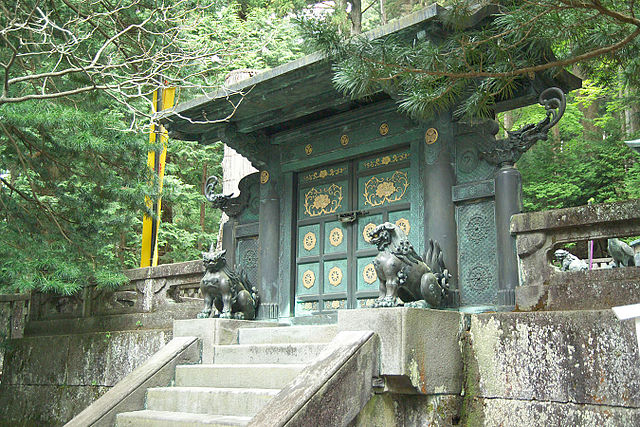 |
| Screen showing battle of Sekigahara |
At noon Kobayakawa Hideaki finally dismounted from his hilltop camp and attacked Otani Yoshitsugu, an erstwhile ally. By 2.00 pm Ieyasu was able to declare victory and view the heads of his slain enemies.
Ishida was not captured until 27th October, where he had been hiding on Mount Ibuki. He was executed on 6th November.
Round-up of
the remnants of the western armies continued, while Ieyasu followed a policy of
conciliating his enemies; fearing that harsh treatment would drive them back to
their provinces to plot another uprising. Ieyasu’s core supporters were not
given large fiefs in reward for their loyalty, but they were given key
strategic positions around Edo.
Shogun
 |
| Tokugawa Ieyasu |
Ieyasu’s
family were more liberally rewarded and in 1602 Ieyasu married his
granddaughter to Hideyori; using his new wife’s retinue as a means of keeping
an eye on the young man.
In 1600 the
Emperor discussed the matter of his succession with Ieyasu. The Emperor favoured
his second son, while Hideyoshi had been persuaded to order that the eldest son
would be heir. Ieyasu, misliking the eldest son’s sponsors, agreed with the
Emperor, who duly made his second son Crown Prince.
In 1603
Ieyasu was formally proclaimed Shogun, an honour that Nobunaga and Hideyoshi
had been unable to claim, as they had no ties with the Minamoto family. When he
was informed by his retainers that the Daimyos were expecting his elevation to
Shogun, Ieyasu replied
'There is no hurry about that.
The country has to be set in order, and the welfare of the people seen to. That
is the most urgent need. Then the various Lords have to be settled in their new
fiefs. When all that has been done it will be time to look to my own personal
status.’[i]
Edo
Aerial view of Edo Castle
Ieyasu now
set about enlarging his capital, the new administrative centre of the country.
In July 1604 Ieyasu ordered that the Daimyos prepare to supply materials and
labour to construct the city. An area of swamp was reclaimed from the sea and
hills were levelled, creating a plain where the city was to be constructed.
The works
were inspected by Ieyasu, until his retirement and then by Hidetada. That even
the great Daimyos were concerned about the quality of the work and materials is
evidenced by letters of the time. Masuda Motoyoshi, chief councillor of Mori
Terumoto wrote
‘Ogosho Sama [Ieyasu] has
been short-tempered, and I am very apprehensive……..We must indeed be very
careful. And again, Mori and Kikkawa were not in time with their supplies. It
is nothing to laugh at. The arrangements have got out of order, and I am very
anxious about it.’[ii]
By June 1606
the majority of the first stage of the building work had been completed and
Ieyasu handed out presents and compliments to those who had participated. In
1607 further orders for building were sent out and then again in 1611. The
Daimyos, eager to be close to the source of power, began their own construction
programmes in the city, building homes for themselves and families. The
building of Edo financed by the Daimyos continued a tradition Hideyoshi had
observed, of reducing the finances of those who might rise up against the
regime.
Foreigners
Several of
the Dutchmen who had arrived in the Liefde had been taken into the service of
Matsura Shigenobu, Lord of Hirado. The captain and supercargo obtained
permission to go home in 1605, with an invitation to Dutch merchants to come to
Japan. Will Adams was not so fortunate. Ieyasu found him too useful.
Jacques Specx
In 1609 the
Brach from the Netherlands arrived in Japan and its captain Specx met with
Ieyasu presenting him with a letter from the Stadtholder. Ieyasu replied to the
latter and gave a grant for Dutch ships to enter any port in Japan, the
commencement of a trading advantage for the Dutch that lasted three hundred
years.
In an
attempt to overturn the concession given to the Dutch; the Spanish and
Portuguese claimed that the Dutch were pirates. Adams appears to have overset
this notion in his conversations with Ieyasu, giving him a relatively unbiased
opinion of the situation in Europe.
Specx
returned to Japan in 1612, with another letter from Prince Maurice.
‘My pen cannot express the
feelings of gratitude with which I have received your honoured epistle sent
from a realm so far distant. And I am beyond measure thankful for the gracious
permission that you have given to the Dutch merchants who have arrived in Japan
to trade freely in your domains.’[iii]
In his
letter Prince Maurice rebutted the accusations of the Spanish and the
Portuguese and claimed that their priests wanted to convert all Japan to
Catholicism. This letter helped confirm the Shogun’s belief that the activities
of the Catholic missionaries in Japan were a menace.
Jesuit priest with a Japanese nobleman
The
Spaniards were not slow to send a representative whose demands on Ieyasu were
staggering in their breadth and impertinence; the expulsion of the Dutch,
mining rights, freedom to proselytise, freedom for Spanish ships to go wherever
Japanese government ships sailed, provision of materials for shipbuilding, a
separate justice system for Spanish residents in Japan; a seemingly endless
list of arrogant demands.
Ieyasu
wished to encourage foreign trade and shipbuilding and was happy to encourage
Spanish involvement; but he set himself against the importation of Christianity
into Japan, believing that it was incompatible with Japanese history, culture
and mentality.
In 1614
Ieyasu ordered the expulsion of all Jesuits from Japan, forbidding samurai and
nobles to profess Christianity, although allowing farmers and tradesmen to do
so.
Retirement
In 1605
Ieyasu officially retired becoming Ogosho[iv], leaving Hidetada to take
his place as Shogun. He continued to rule Japan until his death. Ieyasu
suggested that Hideyori leave Osaka to pay his respects to the new Shogun.
Hideyori’s mother objected to her son leaving the safety of Osaka. Many of
Hideyoshi’s former adherents were dying off, reducing the loyal support base
for his son.
Ieyasu had
been working to isolate Hideyori and he ordered the Daimyos to stop the
practise of calling on him at Osaka, before visiting Sumpu[v] or Edo. Ieyasu had
encouraged Hideyori and his mother to spend money rebuilding the Great Buddha
built by Hideyoshi. The rebuilding was completed in 1614 and a new bell was
cast. The inauguration of the new building was stopped on the grounds that the
new bell was an insult to the Shogun and his family on a number of
hair-splitting grounds.
Osaka Castle
Hideyori had
apparently been trying to attract samurai into his service and his uncle Oda
Yuraku had been sounding our Daimyos for support for his nephew. Honda, a
Tokugawa adviser informed the Hideyori faction that the Shogun believed that
Hideyori should leave Osaka for some other province. Hideyori and his advisers
could not accept such proposals and Ieyasu ensured that rumours of his
intentions to rebel against the Shogunate circulated throughout Japan. He then
decreed a casus belli and attacked.
Hideyori
appealed to the Daimyos for support, but his call was not answered. He had
90,000 freelance samurai to defend Osaka Castle, while the Daimyos answered the
Tokugawa call for levies. Hidetada was in charge of the siege, but Ieyasu
visited in mid-November commenting
‘The inner part of the
castle is very strong, and will be difficult to take, even if we carry the
outer. We must adopt a waiting policy, and hem them in by fortified works, and
so cut off all their communications. Let the Shogun see to this, and I will go
hawking in the Kinai district.’[vi]
The
defenders after suffering a series of bombardments agreed to the castle’s moats
being filled in and Ieyasu’s men worked day and night to level the castle’s
defences. The agreement stated that Hideyori’s status would not be altered in
any way and hostages were sent to Edo. Following the peace all the Daimyos were
excused from further public works for three years.
But
information was soon available to the effect that the defenders were busy
refortifying the castle; in May 1615 the Shogun’s army marched to quell the
defiance of Hideyori’s supporters. After a close fought battle the Shogun’s
army invaded the castle where Hideyori, his staff and his mother killed
themselves. Later Hideyori’s young son was executed. Ieyasu’s step-granddaughter[vii] was saved from the castle
and was later remarried to a member of the loyal Honda family.
Death
Ieyasu's grave
It is
possible that Ieyasu died from cancer of the stomach. He had always lived
frugally and was healthy, but he suffered an illness in the summer after the
fall of Osaka, which he recovered. The Emperor was now persuaded to name Ieyasu
Dajodaijin and Ieyasu attended the ceremonies to celebrate his commission,
despite a re-occurrence of his illness. During this last illness he received
many of the great Daimyo, calling to present their respects. Ieyasu died on 1st
June 1616.
The Christian Martys of Nagasaki
His
‘retirement’ meant that no change was formally necessary as Hidetada was
already in post as Shogun. Hidetada was ill-disposed towards Christians,
enacting anti-Christian legislation, forcing Christian Diamyo to commit
suicide, forcing other Christians to deny their beliefs and executing 55
Christians in Nagasaki. The Togukawa Shogunate stayed in power until 1867, when
the modernising influences from abroad finally toppled the family from their
hold on power.
Bibliography
Sekigahara –
Anthony Bryant, Osprey Publishing Ltd 1995
Samurai
William – Giles Milton, Hodder & Stoughton 2002
The Maker of
Modern Japan – AL Sadler, Charles E Tuttle Company 1983
Tokugawa
Ieyasu Shogun – Conrad Totman, Heian 1983
En.wikipedia.org
[i] The Maker of Modern Japan - Sadler






The wording on the bell being considered as an insult is one of the most spurious pieces of casuistry I have ever come across even from Ieyasu. However he didn't trust Yodo-dono not to manipulate her son Hideyori, and feared war breaking out again. Ieyasu's daughter, wife of Hideyori, Senhime, had adopted the daughter of a dead consort of her husband. Hideyori's son Kunimatsu was outspoken against the Shogun and might easily have been another figurehead for Ieyasu's and Hidetada's enemies, a harsh age.
ReplyDelete